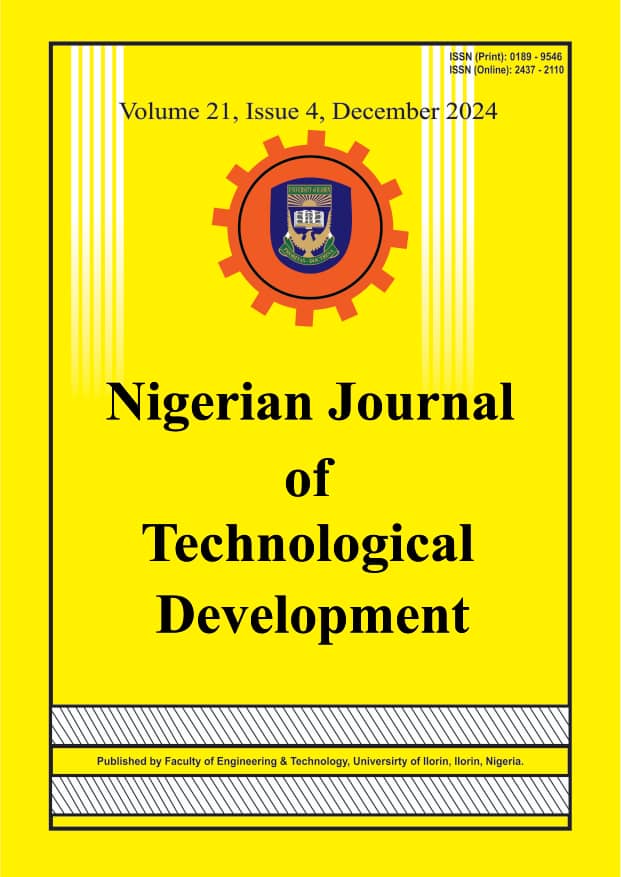Design and Fabrication of a Mechanical Sweeper
DOI:
https://doi.org/10.63746/njtd.v21i4.2781Keywords:
Sweeper brush, Suction blower, Electric motors, Adjustable lever mechanism, Debris collectorAbstract
Encouraging clean and hygienic public areas is made more difficult by urbanization and growing population density. Current cleaning techniques can sometimes be ineffective, not environmentally friendly, unsustainable to handle different variety of debris and mostly expensive as they are imported into the country. This study presents the design and construction of an innovative mechanical sweeper from locally sourced materials to handle street and walkway cleaning challenges. By utilizing simple technique and employing locally available materials, the sweeper collects debris and eliminates negative effects of gasoline powered sweeper on the environment. Sturdy features include a mop function for thorough particle removal, an adjustable lever mechanism for agility, and a flexible brush configuration for cleaning various variety of surfaces. Testing the sweeper in different conditions on different types of trash, confirms the sweeper’s ability to clean adequately as the designed sweeper with a single 24v battery and 0.5 hp electric motor gave a cleaning efficiency above 58%. The simulation and analysis of the sweeper frame using SOLIDWORKS 2018 gave a maximum displacement of 1.621x10-1 mm, maximum strain of 2.415x10-5, maximum stress of 9.167x106 N/m2 and factor of safety of 3. The results of the analysis suggest that the sweeper has been well-designed and can withstand the loading conditions it has been designed for. The application of the sweeper can ensure notable gains in environmental sustainability, operational effectiveness, and cleanliness.
References
Abubakkar, A., Achuthan, R., Shankar, S. G., Yeasigan, S., & Kumar, K. M. (2021). Design and fabrication of mobile app-controlled floor sweeper. Materials Today Proceedings, 55(4), 365–369.
Adedeji, K. A., & Adebesin, A. A. (2020). Design and Construction of a Streetsweeping Machine. International Journal of Engineering Applied Sciences and Technology, 5(2), 626–630.
Amato, F., Querol, X., Johansson, C., Nagl, C., & Alastuey, A. (2010). A review on the effectiveness of street sweeping, washing and dust suppressants as urban PM control methods. Science of The Total Environment, 408(16), 3070–3084
Bi, Z., & Mueller, D. (2016). Finite element analysis for diagnosis of fatigue failure of composite materials in product development. The International Journal of Advanced Manufacturing Technology, 87, 2245–2257.
Bi, Z. (2019). Applications—Solid Mechanics Problems. In Finite Element Analysis Applications - A Systematic and Practical Approach (pp. 281–339). Academic press.
Charnock Equipments Pvt. Ltd. Sweep Care Mechanical Sweeper C 20. Charnock. Accessed date 30 July, 2024.
D’Andrea, D., Risitano, G., & Alberti, F. (2022). Fuel Consumption Reduction and Efficiency Improvement in Urban Street Sweeper Using Power Split with Lockup Clutch Transmission. Applied Sciences (Switzerland), 12(19). Accessed date 30 July, 2024.
Floorbotics. (2024). Revolutionizing Cleaning: The Power of Autonomous Robotic Floor Cleaners. https://floorbotics.com.au/commercial-robot-cleaner/revolutionizing-cleaning-the-power-of-autonomous-robotic-floor-cleaners, Accessed date 8 November, 2024.
Glotelho Inc. KARCHER KM 70/20 C mechanical sweeper, perfect sweeping for outdoor use. Glotelho Ecommerce. https://glotelho.cm/en/mechanical-sweeper-karcher-km-70-20-c-06-month.html, Accessed date 30 July, 2024.
Hako Machines Ltd. Citymaster 2250. https://www.hako.co.uk/machine/citymaster-2250/, Accessed date 30 July, 2024
Hazimi, H., Sabino, U., Putra, A. E, Cahya, H., Saputra, M. Z., & Imaduddin, F. (2018). Vertical bending strength and torsional rigidity analysis of formula student car chassis. AIP Conference Proceedings, 1931.
International Centre for Investigative Reporting (2020). Lagos spent half a billion on machine sweepers but still makes poor women clean highways. International Centre for Investigative Reporting. https://www.icirnigeria.org/lagos-spent-half-a-billion-on-machine-sweepers-but-still-makes-poor-women-clean-highways/
Javaid, M., Haleem, A., Rab, S., Singh, R. P., & Suman, R. (2021). Sensors for daily life: A review. Sensors International, 2.
Kairouz, K., & Price, D. (2013). Identifying Energy Using Components in Exhaust Ventilation Systems. Rehva Journal, March 2013.
Meng, X., Huang, Y., Cao, J., Shen, J., & Santos, J. F. dos. (2021). Recent progress on control strategies for inherent issues in friction stir welding. Progress in Materials Science, 115.
Raihan, I., Lubis, M., Siregar, A. M., Siregar, C. A., & Affandi. (2024). Design and manufacture of mechanical drive systems for road sweepers on flat surfaces. JTTM Jurnal Terapan Teknik Mesin, 5(1), 144–148.
Prassler, E., Schwammkrug, D., Rohrmoser, B. & Schmidl, G. (2000). A robotic road sweeper. IEEE International Conference on Robotics and Automation, 3, 2364–2369.
Sweeping Corporation of America. The History of Street Sweeping. https://www.sweepingcorp.com/learninglibrary/the-history-of-street-sweeping/ Accessed date 30 September, 2024.
Walker, T. A., & Wong, T. H. F. (1999). Effectiveness Of Street Sweeping for Stormwater Pollution Control. Coorporative Research Centre for Catchment Hydrology.
Yahaya, S. A., & Abdulrahman, K. O. (2018). Static fatique analysis on the load container of a low-cost vehicle for Nigerian rural farmers. Nigerian Journal of Technology (NIJOTECH), 37(4), 907–912.

Downloads
Published
Issue
Section
License
Copyright (c) 2024 Nigerian Journal of Technological Development

This work is licensed under a Creative Commons Attribution-NonCommercial-ShareAlike 4.0 International License.
In accordance with the Copyright Act of 1976, which became effective January 1, 1978, the following statement signed by each author must accompany the manuscript submitted: "I, the undersigned author, transfer all copyright ownership of the manuscript referenced above to the Nigerian Journal of Technological Development, in the event the work is published. I warrant that the article is original, does not infringe upon any copyright or other proprietary right of any third party, is not under consideration by another journal, and has not been published previously. I have reviewed and approved the submitted version of the manuscript and agree to its publication in the Nigerian Journal of Technological Development." A copyright transfer form can be downloaded from the NJTD Website (http://njtd.com.ng/index.php/njtd). Author(s) will be consulted, whenever possible, regarding republication of material. All authors must have access to the data presented, and the authors and sponsor (if applicable) must agree to share original data with the editor if requested.





